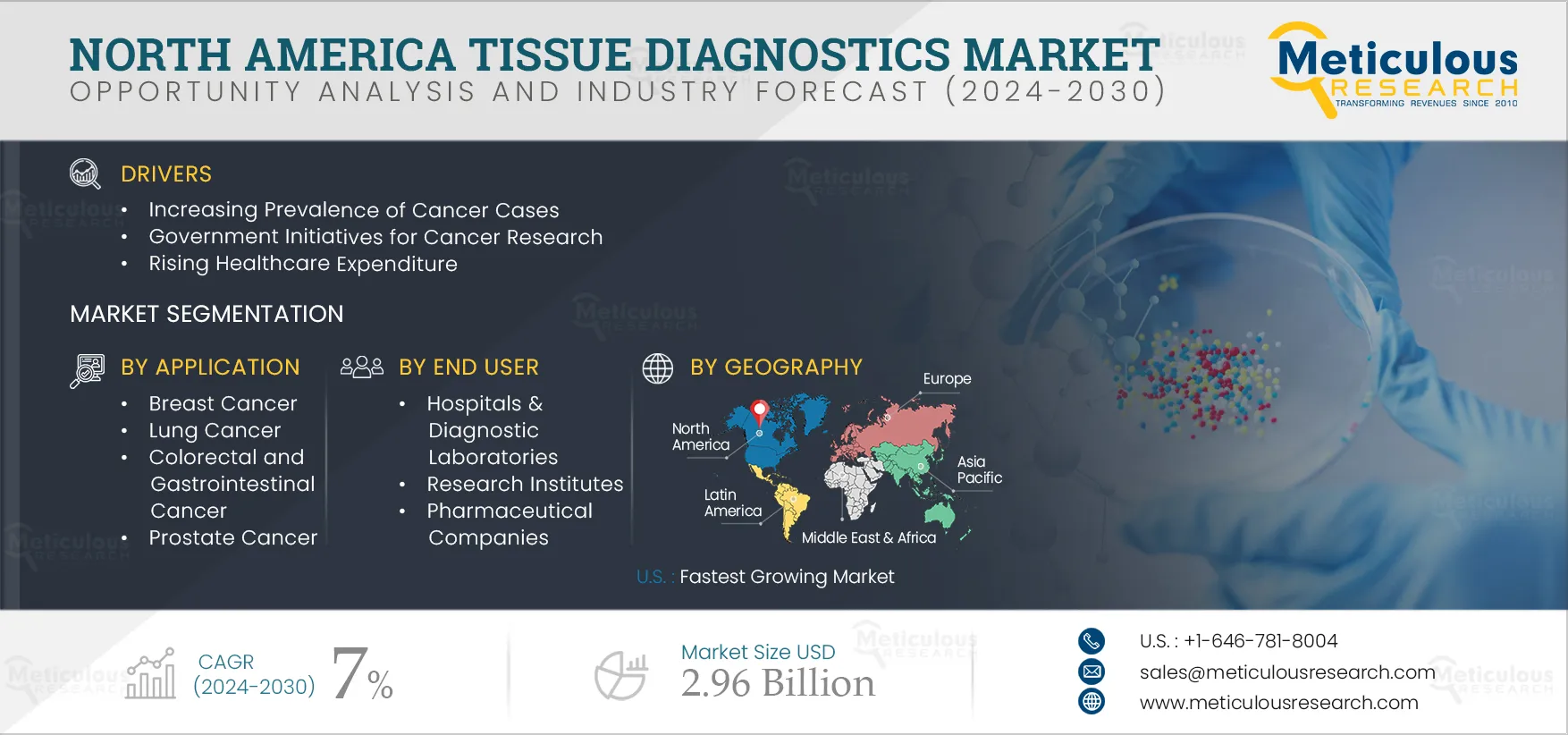Resources
About Us
North America Tissue Diagnostics Market by Product Type (Antibodies, Kits, Reagents, Instruments [Slide Stainer, Scanner]), Technology (Digital Pathology, IHC, ISH, H&E Staining), Cancer Type (Breast, NSCLC, Colorectal, Prostate), and End User - Forecast to 2032
Report ID: MRHC - 104871 Pages: 155 Jan-2025 Formats*: PDF Category: Healthcare Delivery: 24 to 72 Hours Download Free Sample ReportThe North America Tissue Diagnostics Market is expected to reach $2.96 billion by 2032, at a CAGR of 7% during the forecast period 2025–2032. Tissue diagnostics involves the study of tissue to diagnose disease and determine the type of the tissue, whether it's cancerous, and the characteristics of observed cancer. It uses instruments such as slide staining systems, slide scanners, tissue processing systems, embedding systems, and tissue microarrays.
The increasing prevalence of cancer, rising healthcare expenditure, advanced infrastructure for cancer diagnosis, recommendations/guidelines and programs for cancer screening and government initiatives for cancer research are the key factors driving the tissue diagnostics market in North America. In addition, the inclination towards personalized healthcare, growing awareness regarding early disease diagnosis, and adoption of digital pathology & automation in tissue diagnostics are expected to offer significant growth opportunities in the market.

Click here to: Get a Free Sample Copy of this Report
According to the American Cancer Society, cancer is a leading cause of death, accounting for around 608,570 deaths in the U.S. in 2021. Prostate, lung, and colorectal cancers are common in men and breast and colorectal cancers in women. Cancer incidence is increasing due to unhealthy diets, tobacco use, alcohol consumption, sedentary lifestyles, carcinogen exposure, obesity, and pollution. Early detection is critical in reducing mortality, improving the chances of survival, and saving on treatment costs. The burden of cancer is growing in North America due to the growing population, changing lifestyles, people living longer and others.
Lung cancer is the second most common cancer in men and women. According to the GLOBOCAN, in 2020, it is estimated that around 253,537 new lung cancer cases were diagnosed, and it is expected to reach up to 352,415 by 2040. Most older adults are diagnosed with cancer due to declining bodily functions and immunity. The people diagnosed with lung cancer are usually 65 years and above.
Early diagnosis and the exact nature of the tumor detected are important in cancer diagnostics. Early cancer detection and access to effective anti-cancer treatments can improve patients’ survival rates and quality of life. Thus, the overall scenario indicates that the rising prevalence of cancer is expected to boost the demand for tissue diagnostics in North America, driving the market.
Screening tests are used to detect cancer before a person has any symptoms. Cancer screening programs aim to reduce mortality and morbidity through early detection and treatment. The American Cancer Society's (ACS) recommendations & guidelines for screening certain cancers are useful for early detection. In 2021, the American Cancer Society launched the ‘Get Screened’ campaign to encourage people to schedule regular cancer screening tests. Although the COVID-19 pandemic resulted in cancer screening procedures being put on hold, the American Cancer Society's Get Screened initiative aimed to increase cancer screening rates by raising awareness about the importance of recommended screenings. In June 2021, PatientPoint, a patient engagement platform, launched a point-of-care campaign to promote the ACS Get Screened initiative. This point-of-care campaign highlighted the importance of routine cancer screening across nearly 100,000 healthcare providers in more than 25,000 offices in the country.
Key Findings of North America Tissue Diagnostics Market Study:
The Consumables Segment is Expected to Dominate the North America Tissue Diagnostics Market in 2025
Among the product types, in 2025, the consumables segment is expected to account for the largest share of the market. Factors such as the recurring requirement for consumables and research in developing novel reagents, the frequent use of antibodies, assays & kits in the detection of various infectious diseases, commercial availability of a diverse range of reagents, and increasing demand for COVID-19 testing products are driving the growth of this segment.
The Immunohistochemistry (IHC) Segment is Expected to Dominate the North America Tissue Diagnostics Market in 2025
Among the techniques, in 2025, the immunohistochemistry (IHC) segment is expected to account for the largest share of the market. This segment’s large share is mainly attributed to the high cancer screening rate, technological advancements in IHC, and the availability of reimbursement policies for IHC-based tests. Immunohistochemistry provides variations between different types of tumors; hence it is preferred over conventional enzyme staining techniques, especially in cancer screening.
Based on Application, the Breast Cancer Segment is Expected to Dominate the North America Tissue Diagnostics Market in 2025
Among the applications, in 2025, the breast cancer segment is expected to account for the largest share of the market. The large market share of this segment is mainly attributed to the high incidence rate of breast cancer. Breast cancer is the most prevalent cancer in the world. In 2020, there were 281,591 women diagnosed with breast cancer. The incidence of breast cancer is estimated to reach 316,632 cases by 2032 in the region. (Source: International Agency for Research on Cancer)
In 2025, the Hospitals & Diagnostic Laboratories Segment is Expected to Account for the Largest Share of the North America Tissue Diagnostics Market
Among the end users, in 2025, the hospitals & diagnostics laboratories segment is expected to account for the largest share of the North America tissue diagnostics market. The large market share of this segment is attributed to the high cancer incidence rate, the aging population, the availability of several cancer screening programs, and awareness regarding cancer diagnostics. Hospitals & diagnostic laboratories are the first point of contact for diagnosing or treating diseases. These laboratories perform various tests to help diagnose diseases and ensure the appropriate clinical treatment and prevention planning. They are also adopting advanced technologies to boost cancer diagnosis.
U.S.: Fastest Growing Market
The U.S. is expected to account for the largest share of the North America tissue diagnostics market in 2025. The large market share of the segment is attributed to the high geriatric population coupled with the growing number of cancer cases, government funding and initiatives to promote cancer screenings and the presence of key players in the region.
Key Players
The report offers a competitive landscape based on an extensive assessment of the product portfolio offerings, geographic presence, and key strategic developments adopted by leading market players in the industry over the years. The key players profiled in the North America tissue diagnostics market are F. Hoffmann-La Roche Ltd. (Switzerland), Thermo Fisher Scientific Inc. (U.S.), Abbott Laboratories (U.S.), Danaher Corporation (U.S.), QIAGEN N.V. (Netherlands), Becton, Dickinson and Company (U.S.), Abcam plc (U.K.), Agilent Technologies, Inc. (U.S.), Merck KGaA (Germany), Cell Signaling Technology, Inc. (U.S.), BIO SB Inc.(U.S.), Bio-Genex Laboratories (U.S.), HOLOGIC, INC. (U.S.), and Sakura Finetek Japan Co., Ltd. (Japan).
Scope of the Report:
North America Tissue Diagnostics Market Assessment, by Product Type
North America Tissue Diagnostics Market Assessment, by Technique
North America Tissue Diagnostics Market Assessment, by Application
North America Tissue Diagnostics Market Assessment, by End User
North America Tissue Diagnostics Market Assessment, by Country
Key questions answered in the report:
The North America tissue diagnostics market covers consumables and Instruments for breast, lung, colorectal & gastrointestinal cancer, prostate cancer, lymphoma, and other applications.
The North America tissue diagnostics market is projected to reach $2.96 billion by 2032, at a CAGR of 7% during the forecast period.
The consumables segment is expected to account for the largest North America tissue diagnostics market share in 2025. The large share of the segment is attributed to the factors such as recurring requirements for consumables and research in developing novel reagents and other consumables, wide availability of ready-to-use reagents to eliminate the risk of tissue damages, and several launches of antibodies due to high demand for cancer research.
Based on the technique, the immunohistochemistry (IHC) segment is projected to create more traction over the forecast period.
Based on application, the breast cancer segment is projected to expected to account for the largest share of the North America tissue diagnostics market in 2025 due to the increasing prevalence of breast cancer, the large number of screening programs and the increasing government initiatives & private organizations to improve awareness about breast cancer.
The growing number of cancer cases, rising healthcare expenditure, advanced infrastructure for cancer diagnosis, recommendations/guidelines and programs for cancer screening and government initiatives for cancer research are the key factors driving the growth of the tissue diagnostics market in North America. In addition, the inclination towards personalized healthcare, growing awareness regarding early disease diagnosis, and adoption of digital pathology & automation in tissue diagnostics are expected to offer significant growth opportunities in the market.
The key players profiled in the North America tissue diagnostics market are F. Hoffmann-La Roche Ltd. (Switzerland), Thermo Fisher Scientific Inc. (U.S.), Abbott Laboratories (U.S.), Danaher Corporation (U.S.), QIAGEN N.V. (Netherlands), Becton, Dickinson and Company (U.S.), Abcam plc (U.K.), Agilent Technologies, Inc. (U.S.), Merck KGaA (Germany), Cell Signaling Technology, Inc. (U.S.), BIO SB Inc.(U.S.), Bio-Genex Laboratories (U.S.), HOLOGIC, INC. (U.S.), and Sakura Finetek Japan Co., Ltd. (Japan).


























Published Date: Jan-2025
Published Date: Jan-2025
Published Date: Jan-2025
Published Date: Jul-2023
Published Date: Nov-2022
Please enter your corporate email id here to view sample report.
Subscribe to get the latest industry updates